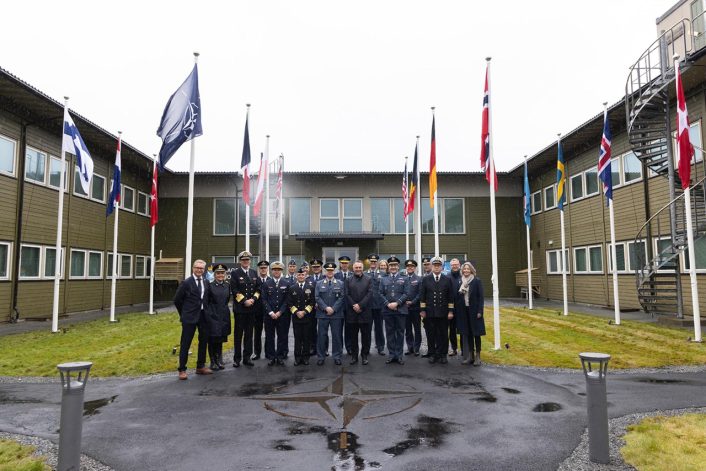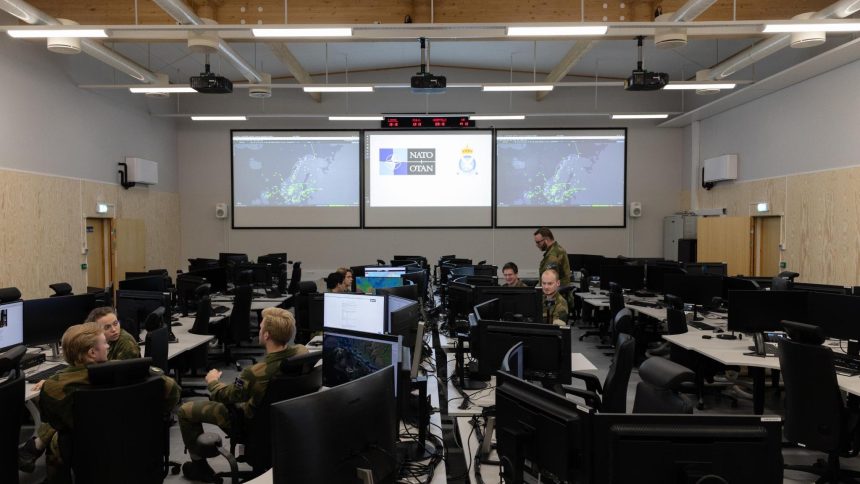CAOC Bodø was officially opened on Oct. 10, 2025, joining CAOC Uedem, Germany, and CAOC Torrejón, Spain as NATO’s third active Combined Air Operations Centre.
Combined Air Operations Centres, or CAOCs – not to be confused with the U.S. Air Force’s 609th Air Operations Centre in Qatar, which is also known as the Combined Air Operations Centre – are NATO’s multinational command and control (C2) nodes for the coordination and direction of allied air assets and air defence.
Bodø will take charge on operations across Scandinavia – bolstered by the addition of Sweden and Finland to the NATO alliance – and the High North, where Russian air activity near NATO airspace is increasingly common. Initially based at Bodø Air Station itself, which has already hosted temporarily deployed CAOCs, the permanent CAOC will move to the nearby Reitan mountain facility when preparatory construction work has been completed. Rygge Air Station was also considered, but not chosen.
NATO’s new Combined Air Operations Center (CAOC) will be located in the High North, at Reitan – outside of Bodø✈️👩💻
The CAOC serves as a command-and-control facility responsible for the coordination of airspace surveillance, as well as the planning and execution of military air… pic.twitter.com/Dfbtz4QVW7
— Norwegian Ministry of Defence (@Forsvarsdep) May 20, 2025
Home to two squadrons of F-16 Fighting Falcons until 2023, Bodø’s role in Norway’s air defence was supplanted by Ørland Main Air Station with the arrival of the F-35A Lightning II. Now, Bodø will take on a wider mission, overseeing the operation of Norway’s quick reaction alert fighter force itself and tasking them, as well as allied NATO aircraft, with intercept instructions.
NATO’s CAOCs monitor as many as 30,000 aircraft movements each day across Europe. The first CAOC was established in 1993, unifying previously separated command structures for air defence and attack operations. Personnel are drawn from across the alliance as well as from the host nation itself. Additionally, many NATO nations also operate Control and Reporting Centres (CRCs) which are the next step down in the command chain from CAOCs, providing more focused coverage across an individual nation or region and managing national air defence missions.
A press release documenting the opening of CAOC Bodø states that the new permanent facility will build critical redundancy into NATO’s air C2 architecture, complementing, rather than replacing, the current two CAOCs. The opening ceremony was attended by NATO officials, along with representatives from Norway, Finland, and Sweden. It concluded with a flypast by a Royal Norwegian Air Force (RNoAF) F-35A Lightning II.
👏 We congratulate @NATO_AIRCOM and Norway on the opening of the Alliance’s third Combined Air Operations Centre (CAOC) in Bodø 🇳🇴!
During the ceremony, our Commander Vice Admiral (VAdm) Doug Perry underscored the importance of this capability:
🗨️ “The opening of this CAOC… pic.twitter.com/cAN2qqKKus
— NATO JFC Norfolk (@JFCNorfolk) October 10, 2025
Above the CAOCs are three Joint Forces Commands – JFC Brunsumm in the Netherlands, JFC Naples in Italy, and JFC Norfolk in Virginia, USA. Norfolk is the newest of the JFCs, having opened in 2018, and oversees the largest area of responsibility of the three – covering the entire eastern seaboards of the United States and Canada, and stretching across the Atlantic to encompass the UK, Iceland, Norway, and the Arctic region.
“The opening of this CAOC marks a new milestone in demonstrating NATO’s preparedness and unity,” said Vice Admiral Doug Perry, Commander of Joint Force Command Norfolk, during the ceremony. “Alongside Norway and AIRCOM, our collective planning, integration, and readiness will continue to evolve and contribute to stability and security across Europe, the Atlantic, High North and Arctic. I am grateful to Norway for their earnest and deliberate efforts in pursuing this important capability.”

CAOC Bodø’s first commander is Major General Tron Strand of the RNoAF. He said “The mission task and our area of responsibility will continue to increase as the organization matures and grows. CAOC Bodø will provide the necessary contributions to the future CAOC model. We will contribute credible deterrence for the Alliance, and we will be ready to fight if necessary.”
Royal Air Force Air Marshal Johnny Stringer, who presently serves as the Acting Commander of NATO Allied Air Command, added: “Today, we inaugurate a critical and pivotal Command and Control node for further securing NATO Airspace. NATO is supremely grateful to the Norwegians for hosting this enhanced C2 capability in the High North.”
NATO’s Evolving Air Defence Picture
NATO’s newest CAOC opens as the alliance faces a more difficult air defence situation than it has for decades. As Russia’s war with Ukraine continues, various NATO member states have reported incidents involving suspected drones operating near airports and sensitive facilities. This followed the direct engagement of Russian attack drones which breached the Polish border with Ukraine last month, subsequently crashing in or being shot down over Polish sovereign territory during a NATO-coordinated air defence effort. Since this intrusion, NATO members have stepped up air defence patrols across the region.
🇵🇱🇷🇺 A map of where in Poland the remains of Russian drones have been found so far.
▪️ As of 11:00am local (10:00am GMT), Polish services had found the remains of seven drones and the remains of a missile.
▪️ As far as I understand, all of the drone parts discovered thus far… pic.twitter.com/UICmMLPzpt
— Status-6 (Military & Conflict News) (@Archer83Able) September 10, 2025
Probing flights by manned aircraft have also continued, most notably on Sept. 19 when three Russian Air Force MiG-31 Foxhound interceptor/strike fighters entered Estonian sovereign airspace. Italian F-35s deployed to Poland as part of NATO’s Enhanced Baltic Air Policing operation were launched to intercept the MiG aircraft, which were inside Estonia’s airspace for around 12 minutes.
On the other side of the globe, U.S. Air Force interceptors have launched on increasingly frequent missions to identify and shadow Russian aircraft detected within the Alaska Air Defense Identification Zone (ADIZ). The ADIZ itself is not sovereign territory, and Russia is within their right to operate in the area, though as the U.S. is responsible for air traffic control within the region the presence of non-transponding aircraft not in radio contact presents a potential hazard to both civilian and military traffic. As well as showing a forceful response, the deployment of armed interceptors is additionally a method of keeping a consistent track of the Russian aircraft and allowing air traffic control to deconflict where necessary.
Two 🇭🇺 Gripen fighters on @NATO Baltic #AirPolicing scrambled on 25 Sep from Siauliai 🇱🇹 in response to a 🇷🇺 Su-30, Su-35 and 3x MiG-31 flying close to 🇱🇻 airspace
🇭🇺 demonstrates the Alliance’s commitment to protecting and safeguarding the Baltics and the eastern flank pic.twitter.com/EMG035s0qm
— NATO Air Command (@NATO_AIRCOM) September 25, 2025
The coincidental timing of many flights within the Alaska ADIZ as well as near NATO airspace in Europe leaves many to conclude that the missions are deliberately coordinated by Russia. A major occurrence in fact took place shortly after a noteworthy speech by U.S. President Donald Trump, who had suggested NATO members could shoot down intruding Russian aircraft and that Ukraine could regain all territory that it has so far lost to Russia.









